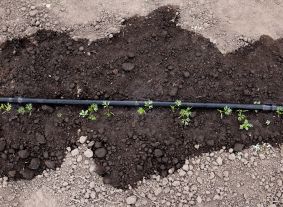How to Save Tomato Seeds
Views: 7020
Last summer I grew some amazing heirloom tomatoes, a variety called Black Cherry with tiny seeds.
Small, round cherry-type tomatoes, the plants grew like weeds and produced like bunnies. I believe I had three or four plants, and that was one or two plants too many. In the end I realized these were the perfect tomatoes to make tomato ketchup. Sweet, low in acidity, and bountiful, I ended up making several batches of the best-tasting homemade ketchup.
That was last summer. What happened this summer? I shopped at several garden centers this spring and could not find the Black Cherry variety anywhere. The other cherry-type varieties I grew just didn’t have the same attributes that would make them ideal for tomato ketchup.
It turns out, however, that my garden neighbor in my new community garden just happened to have Black Cherries growing in her plot this summer. As we’ve been ships passing in the night in the garden, I haven’t been able to ask where she purchased the plants. But it occurred to me that since Black Cherry is an heirloom variety.
perhaps she had harvested and saved the seeds from a previous year and grown the plants herself.
And playing by the community garden rule—“If it hangs over or grows into my plot, it’s fair game”—I plucked a few Black Cherries hanging into my plot to see about trying my hand at saving some seeds.
Open-Pollinated vs. Hybrid Variety
Saving these Black Cherry tomato seeds would only work if they are an open-pollinated variety and not F1 hybrid variety. Think back to middle school genetics class. Seeds of a hybrid plant result in offspring that are not genetically identical to the parent. Seeds of an open-pollinated variety will result in plants that are identical to the parent plant.
All heirlooms are open-pollinated and therefore their seeds can be collected, saved for next season, and planted to give you the same variety for another season.
(If you have ever had “volunteer” tomato plants growing in your garden or compost pile from tomatoes that may have rotted into the ground the previous season, and the plants produced tomatoes that seemed slightly off in taste or texture, those would be the seedlings from a hybrid tomato.)
How to Save Tomato Seeds
1. Remove Tomato Pulp
Working with about ten Black Cherry tomatoes, I removed the tomato pulp, which contains the seeds, and placed it in a rectangular plastic storage container.
2. Add Water
I then added about a cup of water to the seeds, placed a cover on the container, and placed it out of direct sunlight for about three or four days.
3. Strain
I then opened the container, skimmed off the filmy residue that formed on the water surface, and ran the rest of the water and seeds through a fine strainer, cleaning the seeds of any pulpy mass.
4. Dry
I placed the wet seeds onto a paper plate, as I heard the dried seeds would be difficult to remove from paper towel. As the seeds dried over the next few days I would occasionally poke at any seeds I saw drying in clumps to break them up.
5. Store and Label
When the seeds were completely dry, I put them into a small plastic zip-topped baggie and labeled it with the variety and date. I’ll keep them in a cool, dark spot, peeking in on them now and then to make sure nothing funky is growing on them. Come late winter I’ll pot them in some seed-starting mix and wait for them to grow.
And hopefully this time next year I will be enjoying some homemade Black Cherry ketchup. I don’t mind waiting for it.
Meet Ellen Wells
When you’re raised on a farm, you can’t help but know a thing or two about gardening. Ellen Wells is our expert on edible gardening.…
Ellen's Recent Posts

Asparagus






